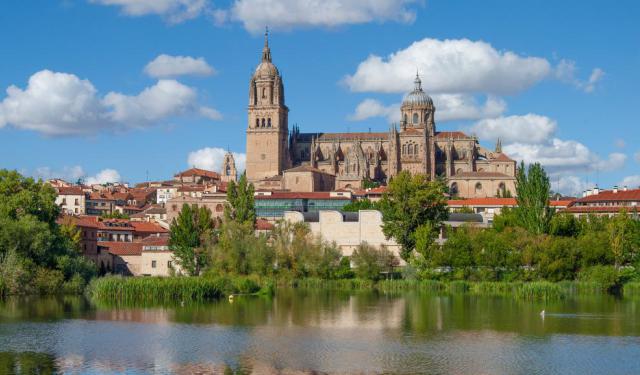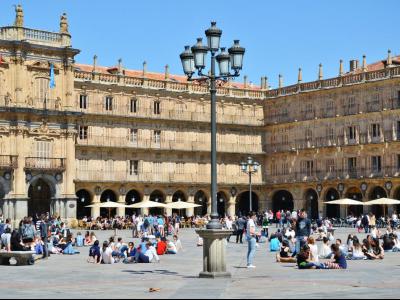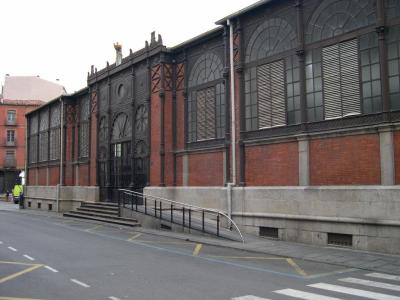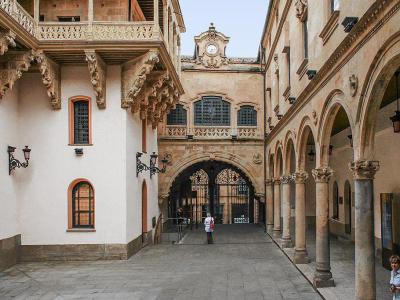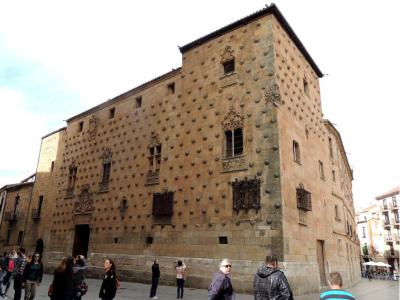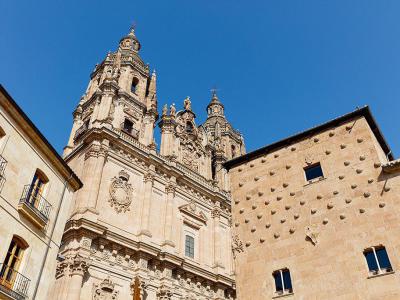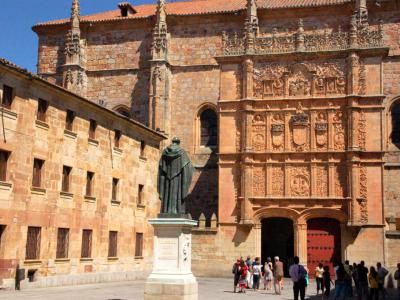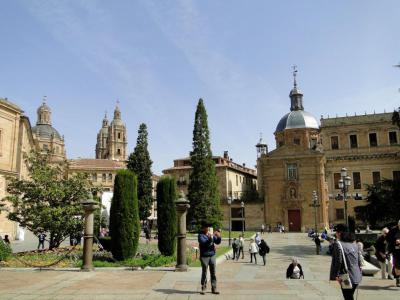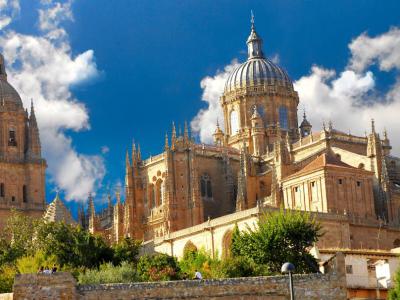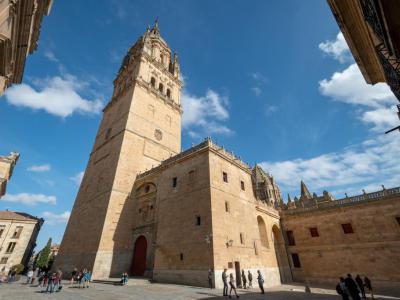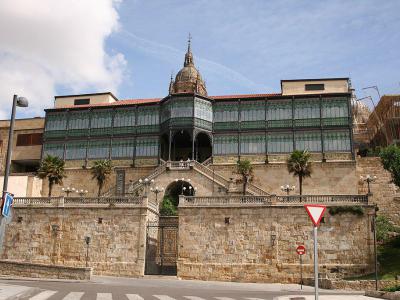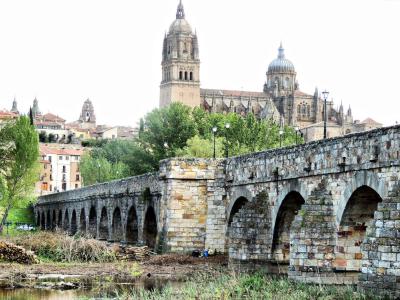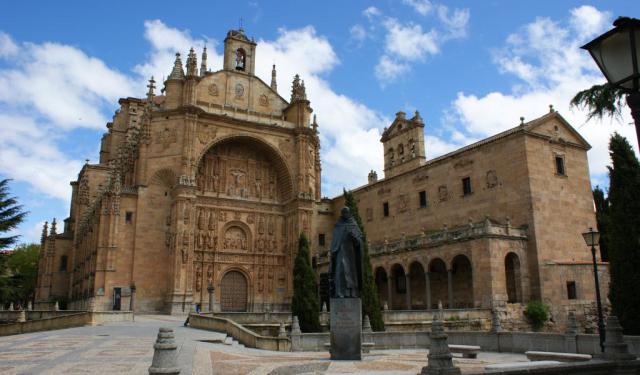Audio Guide: Salamanca Introduction Walking Tour (Self Guided), Salamanca
Usually, frogs inhabit marshy lands, not the sun-baked plains of central Spain. Yet Salamanca is the exception. The small stone frog adorning the façade of the University of Salamanca keeps a watchful eye over visitors. Local legend says that if you find the frog among the carvings, fate will one day bring you back to the city.
The name Salamanca is rooted in antiquity. One theory links it to the ancient name Helmantika, used by Greek geographers and meaning “land of divination,” while other sources cite the Roman name Salmantica. What’s clear is that the city predates Roman rule, inhabited by Celtic-Iberian tribes like the Vaccei and Vettones by the 6th–4th centuries BC.
Around 200 BC, Salamanca fell under Carthaginian pressure, soon followed by Roman domination. As Salmantica, it flourished on the famed Silver Way, becoming an important trading center. After the fall of Rome the city entered a quieter phase until the later Reconquista when Christian forces reclaimed the region in the 11th and 12th centuries.
The real turning point arrived in 1218, when King Alfonso IX of León founded the University of Salamanca. It was officially recognised in 1254 and became a magnet for scholars across Europe. The University rivaled those of Oxford, Bologna, and Paris. Christopher Columbus lectured there. The famed Spanish Conquistador, Hernan Cortes, took classes. The great Spanish writer, Miguel de Cervantes, was an alum and wrote about the goings-on in the region.
During the 16th century, the university sparked the influential “School of Salamanca,” a centre of legal, economic and theological innovation.
Salamanca also bore witness to military upheaval: during the Peninsular War French troops occupied the city until the 1812 Battle of Arapiles turned the tide. In 1988 the old city centre was designated a UNESCO World Heritage Site, in recognition of its rich layers of Romanesque, Gothic, Renaissance and Baroque architecture.
Culturally, February brings the Carnival of the Bull and parades, carnivals, and parties. St. John of Sahagun in June brings bullfights, eating, drinking, and fireworks.
As you walk through Salamanca’s old town, golden-hued sandstone buildings glow in the late afternoon sun. You’ll step into the grand Main Square, a lively Baroque square framed by arcades and cafés. Nearby rises the twin cathedrals—Old and New—while narrow lanes lead you past the ornate House of Shells, draped in shell motifs. Scholar-crowds drift between the ancient portals of the University of Salamanca, where timeless personalities honed in on their craft.
While in the city, do not hesitate to play hide-and-seek with the frog. Spot it, and legend says your path will lead you back here—because in Salamanca, even stone creatures seem to know that no visitor ever truly leaves.
The name Salamanca is rooted in antiquity. One theory links it to the ancient name Helmantika, used by Greek geographers and meaning “land of divination,” while other sources cite the Roman name Salmantica. What’s clear is that the city predates Roman rule, inhabited by Celtic-Iberian tribes like the Vaccei and Vettones by the 6th–4th centuries BC.
Around 200 BC, Salamanca fell under Carthaginian pressure, soon followed by Roman domination. As Salmantica, it flourished on the famed Silver Way, becoming an important trading center. After the fall of Rome the city entered a quieter phase until the later Reconquista when Christian forces reclaimed the region in the 11th and 12th centuries.
The real turning point arrived in 1218, when King Alfonso IX of León founded the University of Salamanca. It was officially recognised in 1254 and became a magnet for scholars across Europe. The University rivaled those of Oxford, Bologna, and Paris. Christopher Columbus lectured there. The famed Spanish Conquistador, Hernan Cortes, took classes. The great Spanish writer, Miguel de Cervantes, was an alum and wrote about the goings-on in the region.
During the 16th century, the university sparked the influential “School of Salamanca,” a centre of legal, economic and theological innovation.
Salamanca also bore witness to military upheaval: during the Peninsular War French troops occupied the city until the 1812 Battle of Arapiles turned the tide. In 1988 the old city centre was designated a UNESCO World Heritage Site, in recognition of its rich layers of Romanesque, Gothic, Renaissance and Baroque architecture.
Culturally, February brings the Carnival of the Bull and parades, carnivals, and parties. St. John of Sahagun in June brings bullfights, eating, drinking, and fireworks.
As you walk through Salamanca’s old town, golden-hued sandstone buildings glow in the late afternoon sun. You’ll step into the grand Main Square, a lively Baroque square framed by arcades and cafés. Nearby rises the twin cathedrals—Old and New—while narrow lanes lead you past the ornate House of Shells, draped in shell motifs. Scholar-crowds drift between the ancient portals of the University of Salamanca, where timeless personalities honed in on their craft.
While in the city, do not hesitate to play hide-and-seek with the frog. Spot it, and legend says your path will lead you back here—because in Salamanca, even stone creatures seem to know that no visitor ever truly leaves.
How it works: Download the app "GPSmyCity: Walks in 1K+ Cities" from Apple App Store or Google Play Store to your mobile phone or tablet. The app turns your mobile device into a personal tour guide and its built-in GPS navigation functions guide you from one tour stop to next. The app works offline, so no data plan is needed when traveling abroad.
Salamanca Introduction Walking Tour Map
Guide Name: Salamanca Introduction Walking Tour
Guide Location: Spain » Salamanca (See other walking tours in Salamanca)
Guide Type: Self-guided Walking Tour (Sightseeing)
# of Attractions: 11
Tour Duration: 1 Hour(s)
Travel Distance: 1.6 Km or 1 Miles
Author: DanaOffice
Sight(s) Featured in This Guide:
Guide Location: Spain » Salamanca (See other walking tours in Salamanca)
Guide Type: Self-guided Walking Tour (Sightseeing)
# of Attractions: 11
Tour Duration: 1 Hour(s)
Travel Distance: 1.6 Km or 1 Miles
Author: DanaOffice
Sight(s) Featured in This Guide:
- Plaza Mayor (Main Square)
- Mercado Central de Salamanca (Salamanca Central Market)
- Palacio de la Salina (Salina Palace)
- Casa de las Conchas (House of Shells)
- The Clergy and Stairway to Heaven
- Universidad de Salamanca (University of Salamanca)
- Plaza de Anaya (Anaya Square)
- Catedral Nueva de Salamanca (New Cathedral of Salamanca)
- Catedral Vieja de Santa Maria (Old Cathedral of Salamanca)
- Museo Art Nouveau and Art Deco (Art Deco and Art Nouveau Museum)
- Puente Romano de Salamanca (Salamanca Roman Bridge)
1) Plaza Mayor (Main Square) (must see)
The Main Square of Salamanca began with a spectacle—quite literally. In 1729, King Philip V ordered a new square built for public gatherings, markets, and, most importantly, bullfights. For over a century, the plaza served as Salamanca’s grand arena where crowds roared as matadors saluted the king’s box. One local tale claims that even when bullfights ended in the mid-19th century, older residents would still gather there on summer afternoons, tracing the imaginary ring in the dust and reminiscing about the “golden bulls of Salamanca.”
The square’s transformation from bullring to beloved civic heart mirrors the evolution of Salamanca itself. Built between 1729 and 1755, it followed the ornate Baroque style that would define the city’s golden sandstone glow. Yet beyond its elegance and symmetry, Main Square became a stage for everyday life. Once hosting royal proclamations, processions, and even public executions, it eventually gave way to laughter, debates, and spontaneous music that filled its arcades long after nightfall.
Balconies that once overlooked bullfights became the perfect place for families to watch parades and celebrations. In the 18th century, Sunday evenings saw young gentlemen circle the square in one direction while the women paraded in the opposite—an elegant social dance that often led to courtship and gossip. Locals called it “el paseo,” a ritual still alive in spirit today when students and travelers gather beneath the same archways to chat, flirt, and share songs under the stars.
Modern Salamanca has kept this rhythm of conviviality. At night, the golden sandstone façades are softly illuminated, and the air fills with the laughter of students and street musicians. One enduring tradition is “tuna music,” performed by black-clad university troubadours who strum guitars and mandolins while serenading passersby—a custom dating back to medieval times.
Today, Main Square remains the city’s living room—a place to sip coffee, enjoy tapas, or simply watch life unfold as it has for nearly three centuries. And if you close your eyes for a moment, you might just hear echoes of hooves, laughter, and song—the timeless pulse of Salamanca itself.
The square’s transformation from bullring to beloved civic heart mirrors the evolution of Salamanca itself. Built between 1729 and 1755, it followed the ornate Baroque style that would define the city’s golden sandstone glow. Yet beyond its elegance and symmetry, Main Square became a stage for everyday life. Once hosting royal proclamations, processions, and even public executions, it eventually gave way to laughter, debates, and spontaneous music that filled its arcades long after nightfall.
Balconies that once overlooked bullfights became the perfect place for families to watch parades and celebrations. In the 18th century, Sunday evenings saw young gentlemen circle the square in one direction while the women paraded in the opposite—an elegant social dance that often led to courtship and gossip. Locals called it “el paseo,” a ritual still alive in spirit today when students and travelers gather beneath the same archways to chat, flirt, and share songs under the stars.
Modern Salamanca has kept this rhythm of conviviality. At night, the golden sandstone façades are softly illuminated, and the air fills with the laughter of students and street musicians. One enduring tradition is “tuna music,” performed by black-clad university troubadours who strum guitars and mandolins while serenading passersby—a custom dating back to medieval times.
Today, Main Square remains the city’s living room—a place to sip coffee, enjoy tapas, or simply watch life unfold as it has for nearly three centuries. And if you close your eyes for a moment, you might just hear echoes of hooves, laughter, and song—the timeless pulse of Salamanca itself.
2) Mercado Central de Salamanca (Salamanca Central Market)
The Salamanca Central Market, just steps from Main Square, has always been the city’s beating heart. Long before the iron-and-glass building opened in 1909, merchants traded under the open skies of medieval Salamanca—first near the Old Cathedral, then by San Martín Church, where the Main Square now stands. Over centuries, the market shifted location, but never lost its role as a gathering place for gossip, bargaining, and local flavor.
When the covered market was finally built at the dawn of the 20th century, stories say that many older vendors resisted at first, claiming the open air made the produce taste better. Yet, once inside the grand new iron structure—with its light pouring through skylights and the comforting smell of bread and cheese—they found a rhythm that endures today.
Morning still begins here with chatter echoing beneath the vaulted roof, vendors calling out prices for Jamón Ibérico, cheeses, and piles of bright oranges and peppers. The market’s hum is a familiar song to generations of Salamancans who return not only to buy, but to belong.
In recent years, the Central Market has embraced the city’s culinary evolution. Amid stalls of fish, legumes, and spices, visitors now find appetizer bars serving wine, pastries, and local meats. It’s not unusual to see students and grandmothers alike sharing a glass of Ribera del Duero wine beside counters where their grandparents once sold produce—a living bridge between past and present in the warm, fragrant air of Salamanca’s oldest market.
When the covered market was finally built at the dawn of the 20th century, stories say that many older vendors resisted at first, claiming the open air made the produce taste better. Yet, once inside the grand new iron structure—with its light pouring through skylights and the comforting smell of bread and cheese—they found a rhythm that endures today.
Morning still begins here with chatter echoing beneath the vaulted roof, vendors calling out prices for Jamón Ibérico, cheeses, and piles of bright oranges and peppers. The market’s hum is a familiar song to generations of Salamancans who return not only to buy, but to belong.
In recent years, the Central Market has embraced the city’s culinary evolution. Amid stalls of fish, legumes, and spices, visitors now find appetizer bars serving wine, pastries, and local meats. It’s not unusual to see students and grandmothers alike sharing a glass of Ribera del Duero wine beside counters where their grandparents once sold produce—a living bridge between past and present in the warm, fragrant air of Salamanca’s oldest market.
3) Palacio de la Salina (Salina Palace)
The Salina Palace in Salamanca is one of those places where beauty and rumor intertwine. Built in 1538 for Rodrigo de Messía, Count of Barajas and the city’s corregidor, it was originally designed to house the salt trade—one of the most valuable goods of its time. Yet behind its stately Renaissance façade lies a far more human story.
According to local legend, Rodrigo’s wife, tormented by jealousy, commissioned the palace’s sculptor to carve grotesque faces, grimaces, and mythical figures into the courtyard’s stonework. Each expression, she claimed, represented the unfaithful husband’s supposed lovers, ensuring that their mockery would haunt him for eternity. Whether true or not, the story gives the courtyard an unmistakable air of mystery—those faces seem to watch you as you move, amused or reproachful, as if still savoring the domestic drama that gave them life.
Over the centuries, the palace has stood witness to Salamanca’s evolving identity. Once filled with salt merchants and noble guests, it now houses the Provincial Council of Salamanca, yet its Renaissance courtyard remains a quiet refuge for those drawn to art and legend. Exhibitions and cultural events occasionally fill its arcades, but the essence of the place lies in its silence—the kind that lets you hear whispers from another time.
Visiting the Salina Palace is like opening a private diary of the Renaissance: restrained elegance on the surface, but beneath it, emotions, vanity, and humor immortalized in stone.
According to local legend, Rodrigo’s wife, tormented by jealousy, commissioned the palace’s sculptor to carve grotesque faces, grimaces, and mythical figures into the courtyard’s stonework. Each expression, she claimed, represented the unfaithful husband’s supposed lovers, ensuring that their mockery would haunt him for eternity. Whether true or not, the story gives the courtyard an unmistakable air of mystery—those faces seem to watch you as you move, amused or reproachful, as if still savoring the domestic drama that gave them life.
Over the centuries, the palace has stood witness to Salamanca’s evolving identity. Once filled with salt merchants and noble guests, it now houses the Provincial Council of Salamanca, yet its Renaissance courtyard remains a quiet refuge for those drawn to art and legend. Exhibitions and cultural events occasionally fill its arcades, but the essence of the place lies in its silence—the kind that lets you hear whispers from another time.
Visiting the Salina Palace is like opening a private diary of the Renaissance: restrained elegance on the surface, but beneath it, emotions, vanity, and humor immortalized in stone.
4) Casa de las Conchas (House of Shells) (must see)
The House of Shells in Salamanca is more than just a building—it’s a love letter carved in stone. Built between 1493 and 1517 by Rodrigo Maldonado, a knight of the Order of Santiago and a professor at the University of Salamanca, it was both a statement of power and a private monument of affection. The façade is covered with more than 300 scallop shells, symbols of the order—and, as legend goes, of Maldonado’s love for his wife, Juana Pimentel, whose family crest also bore the shell.
Locals say that each shell represents a secret devotion, a vow of fidelity that endures in stone. Others whisper that one of the shells hides a treasure, though no one has ever dared to pry them loose to find out. Whatever the truth, the result is a building that draws curious eyes and romantic hearts alike. Under the changing sunlight, the sandstone façade glows golden, and the shells seem to ripple as if stirred by an invisible sea breeze.
Inside, the palace unfolds around a quiet courtyard, an oasis of arches, marble columns, and coats of arms uniting both families. Today, it houses a public library and cultural center, but centuries ago it was a noble home—a place where scholars, poets, and travelers might have gathered to debate, dine, or dream beneath the carved faces of the Renaissance.
Standing before the House of Shells, one feels the blend of intellect, faith, and emotion that defines Salamanca itself. The shells speak of love and loyalty, but also of journeys—pilgrimages of the heart and of the mind. As evening light softens the façade, it’s easy to believe that this house, like the city around it, was built not only to endure but to remember.
Locals say that each shell represents a secret devotion, a vow of fidelity that endures in stone. Others whisper that one of the shells hides a treasure, though no one has ever dared to pry them loose to find out. Whatever the truth, the result is a building that draws curious eyes and romantic hearts alike. Under the changing sunlight, the sandstone façade glows golden, and the shells seem to ripple as if stirred by an invisible sea breeze.
Inside, the palace unfolds around a quiet courtyard, an oasis of arches, marble columns, and coats of arms uniting both families. Today, it houses a public library and cultural center, but centuries ago it was a noble home—a place where scholars, poets, and travelers might have gathered to debate, dine, or dream beneath the carved faces of the Renaissance.
Standing before the House of Shells, one feels the blend of intellect, faith, and emotion that defines Salamanca itself. The shells speak of love and loyalty, but also of journeys—pilgrimages of the heart and of the mind. As evening light softens the façade, it’s easy to believe that this house, like the city around it, was built not only to endure but to remember.
5) The Clergy and Stairway to Heaven
Rising proudly over Salamanca’s golden skyline, The Clergy—once the Royal College of the Holy Spirit of the Society of Jesus—embodies centuries of ambition, devotion, and drama. Commissioned in 1617 by Queen Margaret of Austria and King Philip III, it was meant to train Jesuit missionaries destined for the Americas and Protestant Europe. The Jesuits, known for their learning and influence, designed the building as a declaration of faith and intellect—one that quite literally aimed for the heavens.
Local lore says that when the Jesuits first began construction, the queen herself marveled that its towers might outshine Salamanca’s cathedrals. And indeed, they nearly did. The design was as daring as it was devotional—a Baroque masterpiece whose towers seem to reach for the divine. Yet, history intervened: in 1767, the Jesuits were expelled from Spain, and their grand college was handed over to the Royal Clergy of San Marcos, giving rise to its enduring name, The Clergy.
Centuries later, visitors can experience the same sense of ascent that inspired its creators. The Stairway to Heaven, is a steep wooden staircase of nearly 200 steps that spirals toward the twin towers. At the top, an open walkway links both towers, unveiling breathtaking views of Salamanca—the cathedrals’ domes, the sea of terracotta roofs, and the river beyond.
Today, The Clergy houses the Pontifical University of Salamanca and welcomes travelers seeking both beauty and perspective. Climbing its towers, one cannot help but feel that this “Stairway to Heaven” was never just about reaching the sky—it was about elevating the spirit, just as it has done for centuries.
Local lore says that when the Jesuits first began construction, the queen herself marveled that its towers might outshine Salamanca’s cathedrals. And indeed, they nearly did. The design was as daring as it was devotional—a Baroque masterpiece whose towers seem to reach for the divine. Yet, history intervened: in 1767, the Jesuits were expelled from Spain, and their grand college was handed over to the Royal Clergy of San Marcos, giving rise to its enduring name, The Clergy.
Centuries later, visitors can experience the same sense of ascent that inspired its creators. The Stairway to Heaven, is a steep wooden staircase of nearly 200 steps that spirals toward the twin towers. At the top, an open walkway links both towers, unveiling breathtaking views of Salamanca—the cathedrals’ domes, the sea of terracotta roofs, and the river beyond.
Today, The Clergy houses the Pontifical University of Salamanca and welcomes travelers seeking both beauty and perspective. Climbing its towers, one cannot help but feel that this “Stairway to Heaven” was never just about reaching the sky—it was about elevating the spirit, just as it has done for centuries.
6) Universidad de Salamanca (University of Salamanca) (must see)
The University of Salamanca has always balanced wisdom and legend, a fact immortalized by one of its most famous alumni—Miguel de Cervantes. In his short play The Cave of Salamanca, he teased the city’s reputation for mystery, joking about students learning the dark arts in secret caverns beneath the town. The story may be fiction, but it captures the university’s enduring aura of intellect tinged with wonder.
Founded in 1218 by King Alfonso IX of León, the University of Salamanca quickly became a beacon of learning in medieval Spain. It earned papal recognition soon after, securing its place among Europe’s great universities—alongside Oxford, Paris, and Bologna. During the Renaissance, it was nicknamed the “Athens of the West,” a gathering place for scholars, philosophers, and explorers whose ideas reshaped the world.
It was within these cloisters that Christopher Columbus presented his case for a westward voyage to the Indies, seeking academic and theological approval for what would become one of history’s most defining journeys. Centuries later, the university’s thinkers—Francisco de Vitoria, Domingo de Soto, and others of the famed School of Salamanca—would pioneer modern concepts of human rights, international law, and moral philosophy.
The Plateresque façade of the university remains one of Spain’s great artistic marvels, its golden sandstone carved with intricate symbols of faith and knowledge. Hidden among the decorations sits a small frog perched on a skull, the source of Salamanca’s most famous student legend: finding it means luck in exams; failing to spot it means you’ll be back next year. Even today, anxious students crowd the courtyard, squinting upward for a glimpse of their destiny.
Nearly eight centuries later, the University of Salamanca still hums with life—its lecture halls, libraries, and courtyards echoing with voices in dozens of languages. For travelers, it’s not just a monument to learning but a living organism, where the spirit of curiosity continues to thrive. After all, in Salamanca, even the stones seem to whisper lessons from the past.
Founded in 1218 by King Alfonso IX of León, the University of Salamanca quickly became a beacon of learning in medieval Spain. It earned papal recognition soon after, securing its place among Europe’s great universities—alongside Oxford, Paris, and Bologna. During the Renaissance, it was nicknamed the “Athens of the West,” a gathering place for scholars, philosophers, and explorers whose ideas reshaped the world.
It was within these cloisters that Christopher Columbus presented his case for a westward voyage to the Indies, seeking academic and theological approval for what would become one of history’s most defining journeys. Centuries later, the university’s thinkers—Francisco de Vitoria, Domingo de Soto, and others of the famed School of Salamanca—would pioneer modern concepts of human rights, international law, and moral philosophy.
The Plateresque façade of the university remains one of Spain’s great artistic marvels, its golden sandstone carved with intricate symbols of faith and knowledge. Hidden among the decorations sits a small frog perched on a skull, the source of Salamanca’s most famous student legend: finding it means luck in exams; failing to spot it means you’ll be back next year. Even today, anxious students crowd the courtyard, squinting upward for a glimpse of their destiny.
Nearly eight centuries later, the University of Salamanca still hums with life—its lecture halls, libraries, and courtyards echoing with voices in dozens of languages. For travelers, it’s not just a monument to learning but a living organism, where the spirit of curiosity continues to thrive. After all, in Salamanca, even the stones seem to whisper lessons from the past.
7) Plaza de Anaya (Anaya Square)
Anaya Square, with its serene air and golden glow, is one of Salamanca’s most elegant corners—a place where centuries of faith, learning, and artistry quietly converge. Its centerpiece, the Anaya Palace, owes its existence to both tragedy and vision. The original Royal College of Saint Bartholomew, founded in 1401 by Archbishop Diego de Anaya, was once the pride of Salamanca’s academic life until the Lisbon earthquake of 1755 left it in ruins. Refusing to let the legacy fade, the city rebuilt, and by 1760, a grand new palace rose, showcasing the refined Neoclassical style that was then sweeping Europe.
Legend has it that Diego de Anaya used to walk through the old college gardens, musing on how learning could illuminate the soul like sunlight on Salamanca’s sandstone. Today, his statue still watches over the square, as if ensuring that the spirit of inquiry he fostered endures.
Over the centuries, the Anaya Palace evolved alongside the city. It once hosted the Civil Government and now houses the Faculty of Philology, where students fill the same halls once walked by theologians and scholars of old. Inside, a bust of Miguel de Unamuno stands near the sweeping staircase—a fitting tribute to the writer-philosopher who embodied Salamanca’s intellectual heart.
Outside, Anaya Square remains a haven of calm framed by the New Cathedral and the Church of San Sebastián. Locals and visitors gather on its lawns to read, listen to street musicians, or simply watch the play of sunlight across the stone. It’s a place that perfectly captures Salamanca’s soul—where knowledge and beauty meet beneath the ever-watchful gaze of history.
Legend has it that Diego de Anaya used to walk through the old college gardens, musing on how learning could illuminate the soul like sunlight on Salamanca’s sandstone. Today, his statue still watches over the square, as if ensuring that the spirit of inquiry he fostered endures.
Over the centuries, the Anaya Palace evolved alongside the city. It once hosted the Civil Government and now houses the Faculty of Philology, where students fill the same halls once walked by theologians and scholars of old. Inside, a bust of Miguel de Unamuno stands near the sweeping staircase—a fitting tribute to the writer-philosopher who embodied Salamanca’s intellectual heart.
Outside, Anaya Square remains a haven of calm framed by the New Cathedral and the Church of San Sebastián. Locals and visitors gather on its lawns to read, listen to street musicians, or simply watch the play of sunlight across the stone. It’s a place that perfectly captures Salamanca’s soul—where knowledge and beauty meet beneath the ever-watchful gaze of history.
8) Catedral Nueva de Salamanca (New Cathedral of Salamanca) (must see)
The New Cathedral of Salamanca tells a story that begins with royal impatience and ends in local devotion. In 1509, King Ferdinand II of Aragon, unimpressed by the “small, dark, and low” Romanesque cathedral beside the Tormes River, summoned architects from Toledo and Seville to design a new temple worthy of Salamanca’s growing prestige. Construction began in 1513, a project so ambitious it would not be completed for more than two centuries—its stones aging and styles evolving with time.
The result is a breathtaking hybrid: part Gothic, part Renaissance, and part Baroque—a cathedral that seems to embody Spain’s transformation across the ages. It was built parallel to the Old Cathedral, allowing both to coexist in harmony. Though interrupted by wars, economic troubles, and even the Lisbon earthquake of 1755, which cracked its dome and tilted its tower, the people of Salamanca refused to abandon their great work. The building stood firm, a miracle the townspeople would never forget.
Out of that miracle grew one of Salamanca’s most cherished traditions. When the earthquake struck, terrified citizens rushed inside the cathedral seeking divine protection—and survived without harm. In gratitude, the cathedral’s caretakers vowed that each October 31st, a member of the Mariquelo family would climb to the top of the tower to ring the bells and thank God. For centuries, the ritual endured, the Mariquelo scaling dizzying heights while the crowd below prayed and sang. Revived again in the 1980s, it remains a symbol of the city’s resilience and faith.
Today, visitors marvel not only at the cathedral’s glowing sandstone and celestial ceilings but also at the quirky modern astronaut carving hidden on its façade—a playful touch linking past and present. The New Cathedral stands as both sanctuary and storyteller, reminding all who enter that in Salamanca, faith and time are still measured in stone and sound.
The result is a breathtaking hybrid: part Gothic, part Renaissance, and part Baroque—a cathedral that seems to embody Spain’s transformation across the ages. It was built parallel to the Old Cathedral, allowing both to coexist in harmony. Though interrupted by wars, economic troubles, and even the Lisbon earthquake of 1755, which cracked its dome and tilted its tower, the people of Salamanca refused to abandon their great work. The building stood firm, a miracle the townspeople would never forget.
Out of that miracle grew one of Salamanca’s most cherished traditions. When the earthquake struck, terrified citizens rushed inside the cathedral seeking divine protection—and survived without harm. In gratitude, the cathedral’s caretakers vowed that each October 31st, a member of the Mariquelo family would climb to the top of the tower to ring the bells and thank God. For centuries, the ritual endured, the Mariquelo scaling dizzying heights while the crowd below prayed and sang. Revived again in the 1980s, it remains a symbol of the city’s resilience and faith.
Today, visitors marvel not only at the cathedral’s glowing sandstone and celestial ceilings but also at the quirky modern astronaut carving hidden on its façade—a playful touch linking past and present. The New Cathedral stands as both sanctuary and storyteller, reminding all who enter that in Salamanca, faith and time are still measured in stone and sound.
9) Catedral Vieja de Santa Maria (Old Cathedral of Salamanca) (must see)
The Old Cathedral of Salamanca, officially the Cathedral of Saint Mary, is a solemn survivor of medieval devotion and artistry—its stones whispering stories that predate the city’s Renaissance glory. Founded in 1120 by Bishop Jerome of Périgord, the cathedral rose slowly over two centuries, marking the transition between the solid strength of Romanesque style and the early grace of Gothic design. When King Ferdinand II deemed it “small, dark, and low” in the early 1500s, plans began for a new cathedral beside it—but the old one was never torn down, allowing both temples to coexist like two eras standing shoulder to shoulder.
Inside, time seems suspended. Golden light spills through narrow windows onto frescoes that narrate the life of the Virgin Mary and Christ, culminating in a haunting Last Judgment painted by Nicolás Florentino. One of its treasures is the Tower of the Rooster, named for the weather vane perched atop its conical dome. Locals say the rooster protects the city, and when the wind turns it sharply, it warns of storms—or mischief—approaching Salamanca.
Legends intertwine with history here. In the Chapel of Santa Bárbara, university students once faced the most daunting test of their academic lives: their doctoral examination. Locked inside overnight to prepare, they would emerge at dawn—those who passed through the grand portal, and those who failed through a smaller side door, heads bowed. The practice turned the cathedral into a theater of ambition, humility, and resilience.
Though centuries have passed, the Old Cathedral endures as the spiritual heart of Salamanca. Its cloisters now house a museum, and from the adjoining tower, visitors can look down upon the intimate medieval church and the monumental New Cathedral beyond it. The contrast captures the essence of Salamanca itself—a city where faith, scholarship, and legend intertwine, and where even a weathered rooster keeps watch over eight hundred years of human striving.
Inside, time seems suspended. Golden light spills through narrow windows onto frescoes that narrate the life of the Virgin Mary and Christ, culminating in a haunting Last Judgment painted by Nicolás Florentino. One of its treasures is the Tower of the Rooster, named for the weather vane perched atop its conical dome. Locals say the rooster protects the city, and when the wind turns it sharply, it warns of storms—or mischief—approaching Salamanca.
Legends intertwine with history here. In the Chapel of Santa Bárbara, university students once faced the most daunting test of their academic lives: their doctoral examination. Locked inside overnight to prepare, they would emerge at dawn—those who passed through the grand portal, and those who failed through a smaller side door, heads bowed. The practice turned the cathedral into a theater of ambition, humility, and resilience.
Though centuries have passed, the Old Cathedral endures as the spiritual heart of Salamanca. Its cloisters now house a museum, and from the adjoining tower, visitors can look down upon the intimate medieval church and the monumental New Cathedral beyond it. The contrast captures the essence of Salamanca itself—a city where faith, scholarship, and legend intertwine, and where even a weathered rooster keeps watch over eight hundred years of human striving.
10) Museo Art Nouveau and Art Deco (Art Deco and Art Nouveau Museum) (must see)
The Museum of Art Nouveau and Art Deco in Salamanca, housed in the dazzling Casa Lis, offers a journey into the refinement and imagination of Europe’s early modern age. The story begins with Miguel de Lis, a visionary local entrepreneur who inherited his family’s tanning factory and transformed it through industrial innovation. With his newfound wealth, he dreamed of building a home that would embody progress and artistic flair—a reflection of both his success and the modern spirit sweeping Europe at the turn of the 20th century.
In 1905, that dream materialized when architects designed Casa Lis on the city’s ancient wall. Unlike Salamanca’s heavy stone palaces, this new home gleamed with iron, glass, and color, its façade facing the River Tormes like a beacon of Art Nouveau modernity. The locals, used to conservative architecture, were astonished—and a bit scandalized. Some whispered that the luminous glass façade made the family’s private life “too public,” while others admired its beauty, calling it a “house of light.”
Over time, the house changed owners and fell into neglect until the City Council rescued it in 1981. Painstakingly restored, it reopened in 1995 as the Museum of Art Nouveau and Art Deco, today one of Europe’s finest collections of decorative arts. Visitors can marvel at porcelain dolls, chryselephantine statuettes, Tiffany-style lamps, bronzes, and jewelry, each piece celebrating the craftsmanship of the late 19th and early 20th centuries. Sunlight streaming through stained-glass windows floods the interior with kaleidoscopic colors, turning the building itself into a living artwork.
Beyond its exhibits, the museum preserves the romance and optimism of the Belle Époque. After exploring, visitors can rest in the Lis Cafe, gazing over the Tormes as evening light filters through the famous glass façade. The very openness that once shocked Salamanca’s citizens now invites the world in—proof that Miguel de Lis’s modern dream was, perhaps, just a century ahead of its time.
In 1905, that dream materialized when architects designed Casa Lis on the city’s ancient wall. Unlike Salamanca’s heavy stone palaces, this new home gleamed with iron, glass, and color, its façade facing the River Tormes like a beacon of Art Nouveau modernity. The locals, used to conservative architecture, were astonished—and a bit scandalized. Some whispered that the luminous glass façade made the family’s private life “too public,” while others admired its beauty, calling it a “house of light.”
Over time, the house changed owners and fell into neglect until the City Council rescued it in 1981. Painstakingly restored, it reopened in 1995 as the Museum of Art Nouveau and Art Deco, today one of Europe’s finest collections of decorative arts. Visitors can marvel at porcelain dolls, chryselephantine statuettes, Tiffany-style lamps, bronzes, and jewelry, each piece celebrating the craftsmanship of the late 19th and early 20th centuries. Sunlight streaming through stained-glass windows floods the interior with kaleidoscopic colors, turning the building itself into a living artwork.
Beyond its exhibits, the museum preserves the romance and optimism of the Belle Époque. After exploring, visitors can rest in the Lis Cafe, gazing over the Tormes as evening light filters through the famous glass façade. The very openness that once shocked Salamanca’s citizens now invites the world in—proof that Miguel de Lis’s modern dream was, perhaps, just a century ahead of its time.
11) Puente Romano de Salamanca (Salamanca Roman Bridge)
The Roman Bridge of Salamanca, spanning the Tormes River, is one of the city’s most ancient and beloved landmarks. Built during the Roman Empire—traditionally attributed to Emperor Trajan—it once formed part of the Silver Way, the trade route connecting southern and northern Spain. For nearly two millennia, it has borne the footsteps of merchants, pilgrims, and conquerors entering Salamanca, serving as a literal and symbolic gateway to the city.
Legend, however, gives the bridge an even grander origin. Locals claim it was built by Hercules, the mythical founder of Salamanca, who supposedly taught the townspeople the “arts of wisdom” in a nearby cave before vanishing beyond the river. The story became part of Salamanca’s identity—a city of strength and learning born from myth.
Over the centuries, the bridge has survived floods, wars, and earthquakes, including the 1755 Lisbon earthquake, which shook much of Spain. Despite repeated repairs and reconstructions, especially after devastating floods, fifteen of its original twenty-six arches remain Roman. At the entrance stands a mysterious stone boar, a relic from pre-Roman times believed to mark sacred or grazing lands—a silent guardian watching travelers come and go.
Today, the Roman Bridge is pedestrian-only, offering one of the most breathtaking views of Salamanca. From its stone arches, visitors can watch the golden glow of the Old and New Cathedrals reflected in the Tormes, a sight best seen at dusk. Walking across it feels like stepping through time, from ancient empire to modern city, with each echoing footstep carrying the whispers of history and legend alike.
Legend, however, gives the bridge an even grander origin. Locals claim it was built by Hercules, the mythical founder of Salamanca, who supposedly taught the townspeople the “arts of wisdom” in a nearby cave before vanishing beyond the river. The story became part of Salamanca’s identity—a city of strength and learning born from myth.
Over the centuries, the bridge has survived floods, wars, and earthquakes, including the 1755 Lisbon earthquake, which shook much of Spain. Despite repeated repairs and reconstructions, especially after devastating floods, fifteen of its original twenty-six arches remain Roman. At the entrance stands a mysterious stone boar, a relic from pre-Roman times believed to mark sacred or grazing lands—a silent guardian watching travelers come and go.
Today, the Roman Bridge is pedestrian-only, offering one of the most breathtaking views of Salamanca. From its stone arches, visitors can watch the golden glow of the Old and New Cathedrals reflected in the Tormes, a sight best seen at dusk. Walking across it feels like stepping through time, from ancient empire to modern city, with each echoing footstep carrying the whispers of history and legend alike.
Walking Tours in Salamanca, Spain
Create Your Own Walk in Salamanca
Creating your own self-guided walk in Salamanca is easy and fun. Choose the city attractions that you want to see and a walk route map will be created just for you. You can even set your hotel as the start point of the walk.
Salamanca's Historical Buildings Walking Tour
Salamanca – one of Spain’s most delightful and intriguing destinations – is a treasure trove of architectural marvels. The abundance of well-preserved, centuries-old wonders of construction tucked away in the labyrinth of narrow lanes in this prestigious university city is truly awe-inspiring. A true feast for the eyes, they are so impressive that the entire historic center of Salamanca was... view more
Tour Duration: 2 Hour(s)
Travel Distance: 2.3 Km or 1.4 Miles
Tour Duration: 2 Hour(s)
Travel Distance: 2.3 Km or 1.4 Miles
The Most Popular Cities
/ view all
